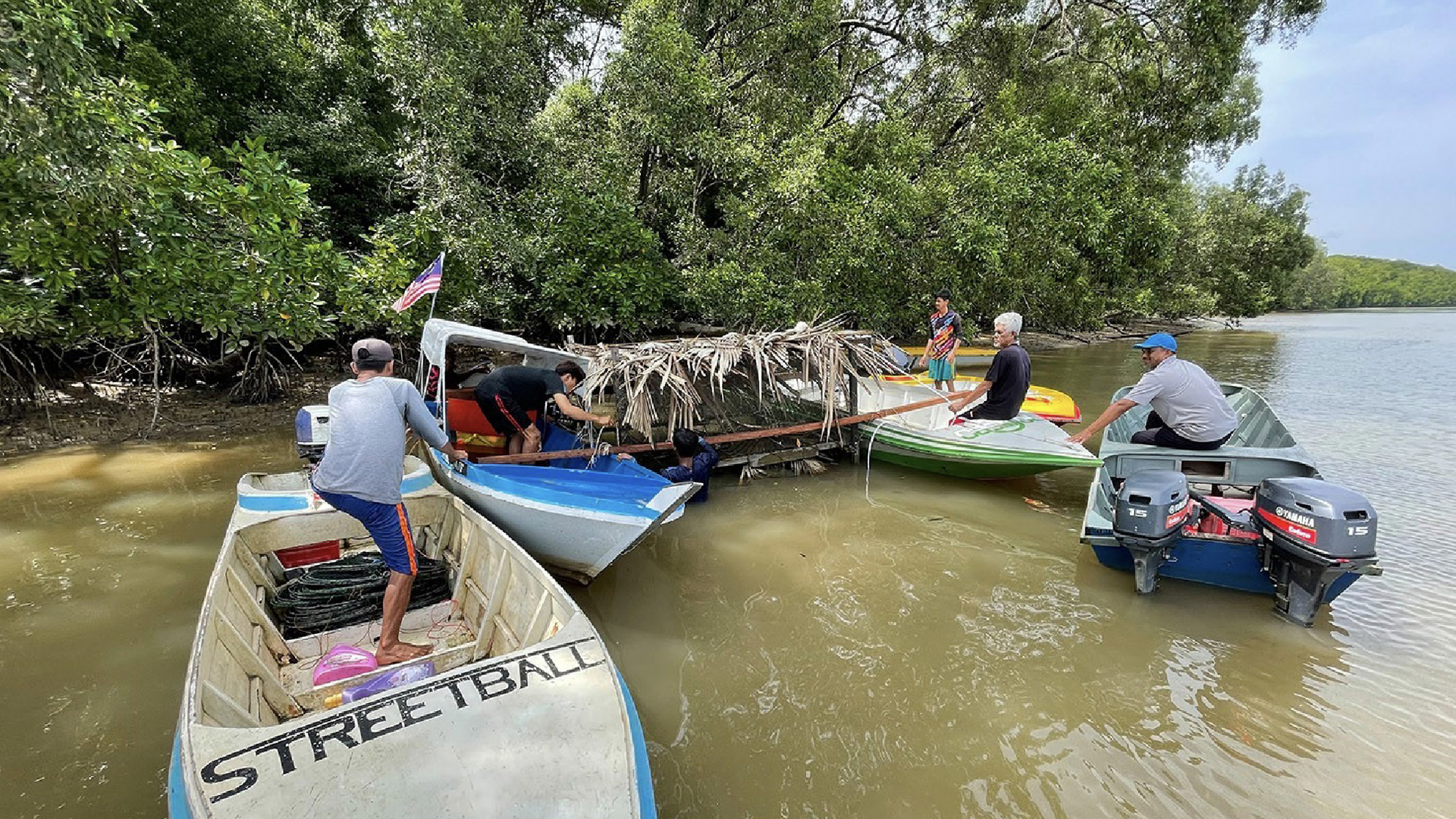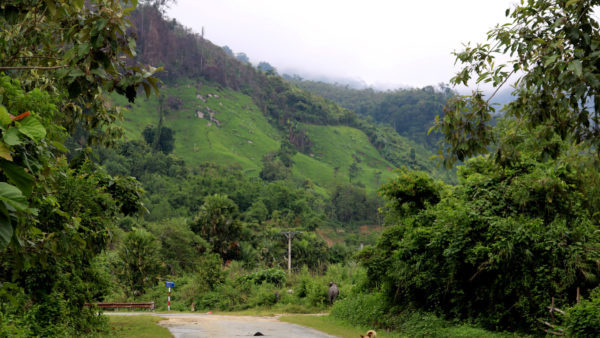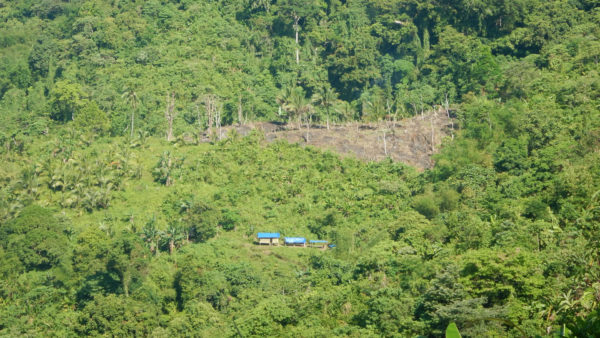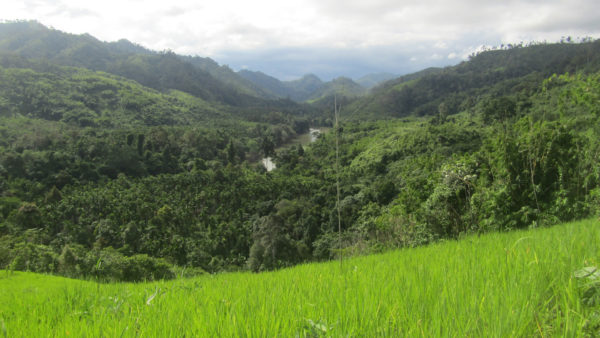First published on 10/20/2023, and last updated on 11/13/2023
By Neville Yapp with Land Empowerment Animals People, Persatuan Komuniti Kampung Mumiang and Forever Sabah
Note: This article is from the recently published report “Celebrating territories of life in Southeast Asia.” The text has been edited for the ICCA Consortium website.
“Our sustenance will be more blessed if we take care of the environment. If we take care of nature, nature will also take care of us and bring us more returns.”
Asmara
Fluorescent lights begin illuminating the river banks along the main channel among the mangroves of the Kinabatangan estuary as people wake up to the call for Fajr prayers. Soon the hot, sharp sun’s rays penetrate through the misty morning dew, accompanied by the chirping of birdlife. Meanwhile, schools of mullet and archerfish wander between the stilts of houses built over the river channels. Asmara eagerly gets into his boat, sets up his rustic boat engine singlehandedly, and takes off.
Asmara lays out his nets in his favourite spot about one hundred meters from his house in Mumiang village’s main river channel, returning with a few snappers, croakers and shad after a mere two hours of fishing. He sells those of suitable sizes to a community-owned cold storage facility, cleans the smaller ones for drying, and keeps a few for food. For Asmara, this is his only way of sustaining his family. He is 75 years old and can no longer toil on the open seas for the lucrative yet uncertain tiger prawns destined for the demanding tourists at famous seafood restaurants in Sandakan.
The people of Mumiang are Suluk, which means man of sea currents. Theirs is a traditional fishing village situated in the mouth of the Kinabatangan River on Sabah’s east coast in Malaysian Borneo. They have coexisted with the coastal habitats and seas for centuries. Many of these communities are orientated to the waters rather than the lands. Asmara and all the people in these villages live by the Islamic calendar to guide their daily lives. This calendar tracks the moon’s cycle, which is reflected in the tides and fish behaviour. Asmara does not require a tides chart, and his body knows the state of the water by counting the days in the lunar month. From about the 5th day after the new moon to the 12th, and leading into the first quarter, Asmara’s fishing schemes take advantage of slower currents and lower tides, while during the full moon, the higher tides mean fish will spread out inside the mangroves, and strong currents mean fishing baits and gill nets will drift. Those parts of the lunar month are reserved for sewing nets and non-fishing activities. Aligning to the rhythms of his watery territory make Asmara a monarch of his own toils.
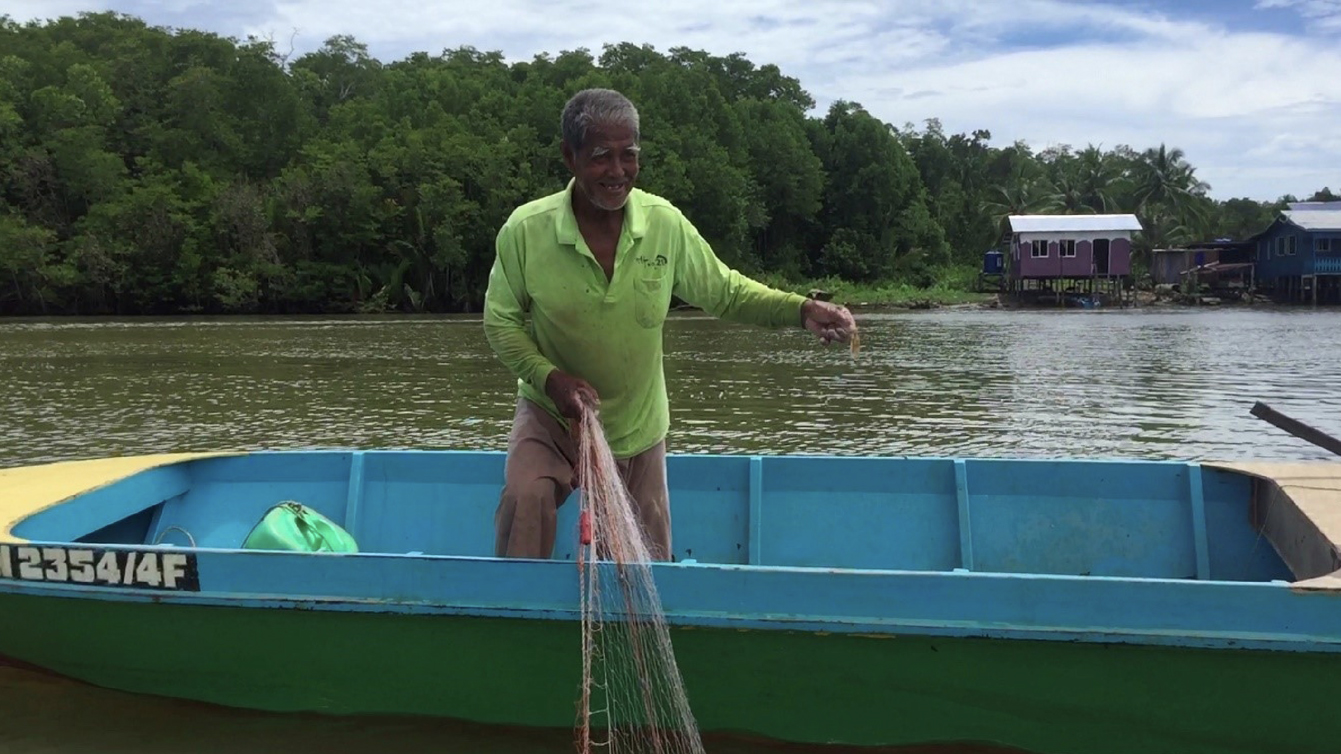
Asmara is also an expert at observing the winds and adjusting the way he fishes to the changing seasons. The angin utara (northeast monsoon), occurring from October to February, brings floods rich in upstream nutrients in a delicate balance. Upon reaching the coastal areas, these nutrients support plankton blooms that catapult mass-spawning events towards the end of the floods. Asmara and his neighbours embrace these annual floods, even as heavy rain and rough seas mean it is a time for the communities to rest. But floods also bring giant freshwater prawns flushed down from hundreds of kilometres upstream. According to him, the yearly influx of freshwater into the tidal creeks helps the village’s caged fish cleanse their gills and bodies from parasites, making chemicals unnecessary.
The arrival of the angin selatan (southwest monsoon) brings a sense of renewal. The calmer seas and more transparent waters in the delta channels mean a new season ideal for hook and line as well as traditional fish traps. It is also a time to visit relatives, hold marriages and festivals, and earn income from tourism, crafts while taking advantage of the daily commute to the city to deliver their fresh fish for sale. Asmara is always ready to share the many taboos and good manners that need to be observed when fishing to avoid danger and make a good catch, including around right behaviour before entering the mangrove forest to collect other resources for subsistence. These are among the many practices and beliefs held by most people in the Kinabatangan and Segama Delta, signifying their sense of respect to the places that have provided for their needs for generations.
The Mumiang territory of life comprises 300km² of coastal mangrove estuary inherited from their ancestors. The Suluk have become divided by modern states that rule from dry land. Mass exploitation of timber and unregulated commercial fishing began in the 1960s and lasted for about three decades, followed by a state-created protected area that overlapped with the Suluk territory. In 2008, the Lower Kinabatangan-Segama Wetlands was designated as a Ramsar site, Malaysia’s largest “wetland of international importance”, without the government formally recognizing the communities’ rights to their territories here. While the authorities knew these communities were long living there they lacked the mechanisms to attend to their inclusion, including because Malaysia’s policy makers had not yet made the commitments now given to advance ICCAs. Despite its ten-year management plan, there is still lack of documentation of traditional ecological knowledge, baselines to assess the health of fisheries stocks and quantifying the socio-economic contribution of small-scale fishing communities for an effective management of fisheries resources in the area. The area also continues to be threatened by land use change which disrupts the balance of the nutrient cycle, creating dead zones to the detriment of the communities who rely on wild-caught fish for their livelihood, as well as threatening endangered species. Sometimes the Northeast monsoon fails, meaning no floods and no prawn season; this has happened several times in the last twenty years.
Even within the community, things are changing. Asmara feels people don’t respect the seas as they used to. People have forgotten the old ways and are shifting to commercial approaches, using less environment friendly fishing gear to make ends meet. There is also much competition as fishers from other areas move in to exploit the remaining productive regions of the Kinabatangan and Segama Delta, creating tension with the locals.
Asmara has a poetic way to describe the reduction of fisheries productivity as a result. He says that “berkat (blessings) from our arduous toils are less than before”. He shared how back in the day people could afford to make the Haji Pilgrimage just from fishing returns. He reminisced with excitement how a single throw of a cast net could fill up a big bucket with prawns. Now they need ten times the effort to catch the same amount with cast nets. This is why many people have started to use three-layered nylon nets, a gear type so effective that many juveniles get caught, reducing the number of juveniles able to grow to mature sizes and spawn.
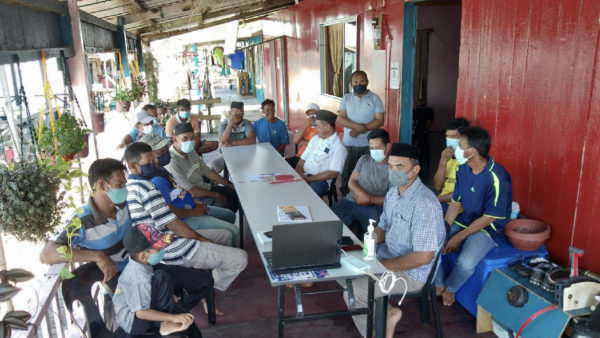
Since 2015, Mumiang and other Territories of Life in the Lower Kinabatangan and Segama Wetlands, facilitated by Land Empowerment Animals People (LEAP), have engaged in a long-term process to regain management of their coastal resources. They have mapped and inventoried their Territories of Life and advanced livelihoods and community organizing skills. A movement developed among women and young people around citizen science, including water quality monitoring and restoration of lowland and mangrove forests. Access to mobile technology has increased significantly over the years, and now the fishermen have been recording their catches using Open Data Kit installed on their mobile phones to see changes in their fishery. These activities have raised local confidence and enthusiasm for more ambitious and comprehensive activities, and have raised capacities to effectively engage in shared governance of the area with State agencies. In 2020, Mumiang community became the first Locally Managed Marine Area (LMMA) in the site.
Since the onset of the pandemic, the community has been driving grassroots discussions and peer learning exchanges on ICCAs and LMMAs. This process has led to the development of a fisheries management protocol launched in late 2021 through a ritual and recitals of verses from Al-Quran led by the village Imam, binding the community together. Ha’alupan bai (waters of our village) is the community’s fisheries management protocol that designates several small areas along the main river channel as no-take zones and enriching them with fish aggregating structures in an effort to recover fish abundance. This is inspired by the knowledge of renggas, their underwater structures along mangrove estuaries and tidal creeks that mimic habitats to attract schools of fish. Ha’alupan bai shelters juveniles and mature fish sizes and encourages the schooling of fish around these structures that have a radius of 50 meters. This management protocol aims to advance shared governance with the Sabah Forestry Department.
Closed for six months with potential conflicts addressed through a series of consultations, the community is targeting the increased abundance of all snapper and grouper species common to the area, including the famed Bornean Black Snapper (Lutjanus goldiei). These structures also reduce the indiscriminate use of gill nets which helps other species such as the Indian Threadfin (Polydactyls indicus), which has been significantly fished in the last two decades. Asmara is an active supporter of the process and has contributed to a rich pool of traditional knowledge alongside other knowledge holders in the process.
Alternative livelihood development is key to the LMMA strategy of Mumiang to diversify sources of income and reduce fishing pressure. With support from local partners, the community has set up a cold storage and processing centre, enabling them to diversify their products and cope with the fishery market disruption caused by the pandemic.
The Tagal System
Malaysia
by Gordon John Thomas
Sabah in the northern Borneo of Malaysia has a population of 3.2 million people, and 61% of them are indigenous. With 32 ethnic groups and over 50 languages, Sabah is unique for its people, nature, culture and customs.
One practice that is well known is the tagal system, a customary practice by the Dusun community. Tagal means “no”, telling communities not to disturb or do any activity in a particular area or resource at a given time. It is a collective ownership and responsibility of the communities in stewardship of their natural resources and has the element of conservation values where it is seen as gompi gonu (use and protect). Other communities have a similar concept, for example, tavol by the Murut communities, puru binondaan in Sungai Tombonuo and bombon in several Dusun communities.
Tagal was initiated by the communities to ensure that the fish stock of their river flourishes and sustains them for generations to come. It protects their resources from irresponsible activities such as overfishing, using illegal fishing methods and polluting the river. The community sets zones which have a set of rules. For example, red zone means no activity whatsoever as this is the breeding ground for fish; yellow zone means there is only a given time to fish, usually once every two to three years depending on the fish stock; and green zone means it is open to all activities. Any wrongdoer will be sanctioned, or have sogit conducted. The tagal system has been accepted and adopted into the Inland Fishery and Aquaculture Enactment in 2003. From this riverine experience, it can be expanded into other resources such as forests and seas, acknowledging the Indigenous Peoples of Sabah as having a best practice in conservation.
